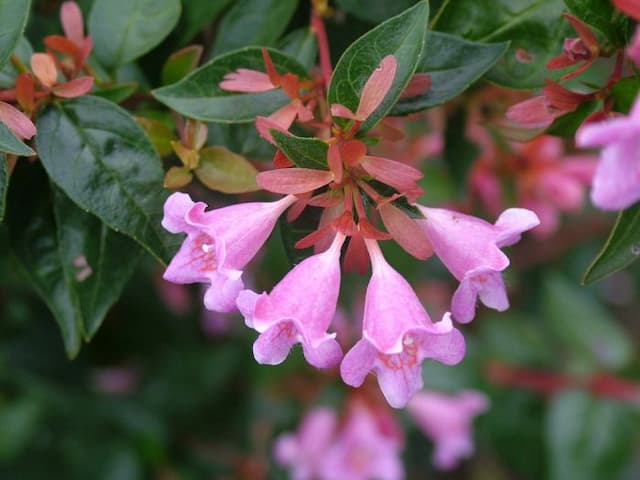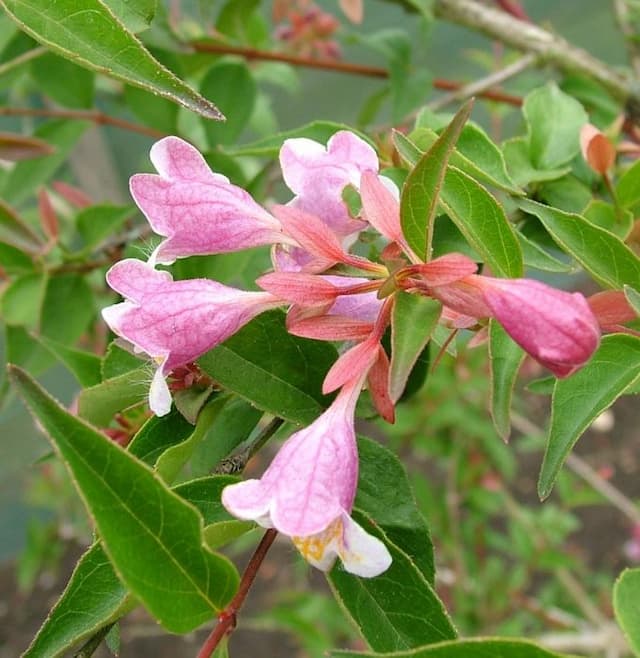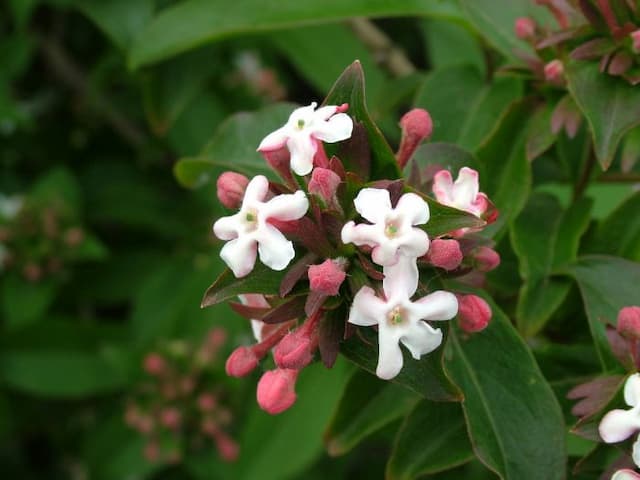Harlequin Honeyberry Lonicera × italica Harlequin = 'Sherlite' (v)
![honeysuckle [Harlequin]](/_next/image?url=https%3A%2F%2Fplants-admin.emdemapps.com%2Fimages%2Fplants%2F%2Fimages%2F604b5f84e94f5.png&w=3840&q=75)
ABOUT
The plant known as Harlequin Honeysuckle is an eye-catching cultivar with various distinctive features that make it stand out in gardens and landscapes. Its leaves are variegated, which means they exhibit multiple colors in a single leaf. Typically, the leaves have a base color of deep green, splashed or edged in creamy white or yellow hues, adding a bright and attractive contrast. The flowers of Harlequin Honeysuckle are striking and aromatic, attracting both gardeners and pollinators like bees and hummingbirds. The blooms are tubular shaped and display a combination of pink and cream colors, sometimes described as bicolored. These flowers are often produced in pairs and present a whimsical appeal as they dangle from the plant. In addition to the variegated foliage and the beautiful flowers, this plant may produce berries that can also be visually striking, usually in shades of red or orange. Their coloration adds yet another layer of interest to the plant's overall appearance, making it a multifaceted ornamental selection for various garden settings. The stems of the Harlequin Honeysuckle are generally twining or climbing, enabling the plant to wrap around structures such as trellises, arbors, or fences. This climbing habit contributes to the plant's charm and versatility, allowing it to add vertical interest in gardens and landscape designs. Overall, the combination of variegated foliage, captivating flowers, and potentially colorful berries makes the Harlequin Honeysuckle a plant that can provide a dynamic visual impact throughout its growing season.
About this plant
 Names
NamesSynonyms
Italian Woodbine, Harlequin Honeysuckle.
Common names
Lonicera × italica 'Harlequin'.
 Toxicity
ToxicityTo humans
The plant known as Italian Honeysuckle has some level of toxicity to humans. Ingesting parts of this plant, especially in large quantities, can lead to gastrointestinal disturbances, including vomiting and diarrhea. Often, the berries are more toxic than the foliage. In some cases, ingestion may cause mild symptoms, but it's advised to keep an eye out for more severe reactions and seek medical attention if symptoms persist or worsen.
To pets
The Italian Honeysuckle is also toxic to pets. If ingested, pets may experience similar symptoms to humans, such as vomiting, diarrhea, and abdominal pain. The berries tend to be more toxic than the leaves. It's important to prevent pets from chewing on or consuming any part of this plant, and if ingestion occurs, seek veterinary care as symptoms can escalate, potentially leading to more severe consequences.
 Characteristics
CharacteristicsLife cycle
Perennials
Foliage type
Deciduous
Color of leaves
Variegated
Flower color
Pink
Height
10 feet (3 meters)
Spread
6 feet (1.8 meters)
Plant type
Climber
Hardiness zones
5
Native area
Cultivar
Benefits
 General Benefits
General Benefits- Aesthetic Appeal: The Lonicera × italica 'Harlequin' offers ornamental value with its variegated foliage and colorful flowers, enhancing the visual interest of any garden or landscape.
- Attracts Wildlife: This honeysuckle variety is known to attract pollinators such as butterflies and bees, promoting biodiversity.
- Fragrance: The flowers emit a delightful fragrance that can add a pleasant aroma to the surrounding area.
- Growth Habit: Exhibits a vining growth habit, making it suitable for trellises, arbors, and fences, providing vertical landscaping options.
- Shade Tolerance: Capable of growing in partial shade, this plant is versatile for different garden aspects.
- Durability: Lonicera × italica 'Harlequin' is relatively hardy and can withstand a range of soil conditions, making it a low-maintenance option for gardeners.
 Medical Properties
Medical PropertiesThis plant is not used for medical purposes.
 Air-purifying Qualities
Air-purifying QualitiesThis plant is not specifically known for air purifying qualities.
 Other Uses
Other Uses- Harlequin honeysuckle can be used in weaving and basketry as the flexible stems allow for intricate and durable creations.
- It can act as a natural fencing material, where its dense growth provides privacy and a decorative green barrier.
- The plant can be trained to grow over arbors or pergolas, providing a shady nook with its lush foliage.
- Harlequin honeysuckle's twining stems are ideal for creating living sculptures by guiding them into various forms over frames.
- Its vines can be used in the garden to support other plants, such as climbing vegetables or as a living trellis.
- The fragrant flowers can be included in potpourris, offering a sweet aroma to homemade mixes.
- Dried honeysuckle vines are sometimes used in the crafting of musical instruments for their resonant qualities.
- Can be used in landscape restoration projects to stabilize soil and control erosion on slopes.
- Its dense coverage can be employed to cover unsightly areas of the garden or structures, helping to integrate them into the landscape.
- Provides an educational resource for horticulture students learning how to prune, train, and propagate climbing plants.
Interesting Facts
 Feng Shui
Feng ShuiThe plant Lonicera (Honeysuckle) is not used in Feng Shui practice.
 Zodiac Sign Compitability
Zodiac Sign CompitabilityThe plant Lonicera (Honeysuckle) is not used in astrology practice.
 Plant Symbolism
Plant Symbolism- Love: Harlequin Honeysuckle, as with many honeysuckles, is often associated with love and affection, perhaps due to its sweet scent and entwining growth habit, symbolizing a close bond or relationship.
- Generosity: Its abundant and vigorous growth can represent the idea of giving without expectation, as the plant generously provides nectar to pollinators.
- Devotion: Honeysuckles are believed to stand for devoted love, as they attach themselves firmly to their support structures, which can parallel the idea of a person being devoted or clingy in a relationship.
- Fertility: With its prolific flowering habit, honeysuckle may also be seen as a symbol of fertility and procreation.
 Water
WaterThe Harlequin Honeysuckle (Lonicera × italica 'Sherlite') prefers evenly moist soils; therefore, a consistent watering schedule is necessary. Generally, watering should occur approximately once a week, with adjustments made for rainfall and temperature conditions. During the active growing season in spring and summer, increase watering frequency to support growth. A good method is to check the top inch of the soil; if it's dry, it's time to water. Provide about 1 to 2 gallons of water at each interval, ensuring a deep soak that encourages root growth without causing waterlogging.
 Light
LightThe Harlequin Honeysuckle thrives best in full sun to partial shade with at least 4 to 6 hours of direct sunlight daily. This plant will tolerate light shade but will flower more abundantly when it has good sunlight exposure. The ideal spot would be in a location that receives morning sun and some afternoon shade, particularly in hotter climates, to prevent stress on the plant from excessive heat.
 Temperature
TemperatureThe Harlequin Honeysuckle can tolerate a range of temperatures but grows best in temperate conditions. This plant is hardy and can survive in temperatures as low as -10 to -20 degrees Fahrenheit but prefers the range of 60 to 80 degrees Fahrenheit for optimal growth. It's important to protect the plant from extreme cold and frosts by providing suitable winter cover if temperatures drop significantly in your area.
 Pruning
PruningPruning Harlequin Honeysuckle is important for shaping the plant, encouraging new growth, and improving air circulation. Light pruning can be done any time throughout the year to remove dead or damaged stems. However, the best time for significant pruning is late winter or early spring before new growth starts. Prune older stems to rejuvenate the plant, and trim back as needed after flowering to keep its growth in check.
 Cleaning
CleaningAs needed
 Soil
SoilThe Harlequin Honeysuckle prefers well-draining soil rich in organic matter with a soil pH of 6 to 8. A good soil mix might include two parts garden soil, one part compost or well-rotted manure, and one part sand or perlite to improve drainage.
 Repotting
RepottingHarlequin Honeysuckle (Lonicera) typically does not need frequent repotting as it is often grown outdoors. It may only need repotting if grown in containers and has outgrown its current pot, which could be every 3-5 years.
 Humidity & Misting
Humidity & MistingThe Harlequin Honeysuckle thrives best with average ambient humidity. It does not have specific humidity requirements, making it versatile, but it's important to ensure that it doesn't dry out completely.
 Suitable locations
Suitable locationsIndoor
Provide bright light, prune to shape, and water regularly.
Outdoor
Full sun to partial shade; mulch and water effectively.
Hardiness zone
4-9 USDA
 Life cycle
Life cycleLonicera × italica 'Harlequin', commonly known as Harlequin Honeysuckle, starts its life as a seed, which when sown germinates in a warm, moist environment. Upon sprouting, the seedling grows into a young plant with distinctive variegated leaves, going through a juvenile phase where it establishes its root system and foliage. As it matures, the Harlequin Honeysuckle enters a vegetative stage, during which it undergoes vigorous growth, intertwining and climbing if given support. Once mature, it produces fragrant flowers in the summer, which attract pollinators and eventually give way to berries. The plant goes through its reproductive cycle annually, with flowers and fruit typically occurring each year once it reaches maturity. In colder climates or during winter, the plant may become dormant, shedding some leaves, but will resume growth with the return of favorable conditions.
 Propogation
PropogationPropogation time
Spring to early summer
The Lonicera × italica 'Harlequin', commonly known as Harlequin Honeysuckle, is typically propagated by semi-hardwood cuttings. The best time to take cuttings is in late summer when the plant's growth begins to slow down and the stems are not too tender or too woody. To propagate by cuttings, select a healthy stem and cut a 6 to 8 inch (15 to 20 cm) length just below a leaf node. Remove the leaves from the lower half of the cutting and dip the cut end into rooting hormone to encourage root growth. Plant the cutting in a well-draining soil mix, making sure to keep the soil moist but not waterlogged. Place the pot in a warm area with indirect light. Roots typically develop within a few weeks, after which the new Harlequin Honeysuckle plant can be gradually acclimated to outdoor conditions.







![Himalayan honeysuckle [Golden Lanterns]](/_next/image?url=https%3A%2F%2Fplants-admin.emdemapps.com%2Fimages%2Fplants%2F%2Fimages%2F604b55302cc87.png&w=640&q=75)

